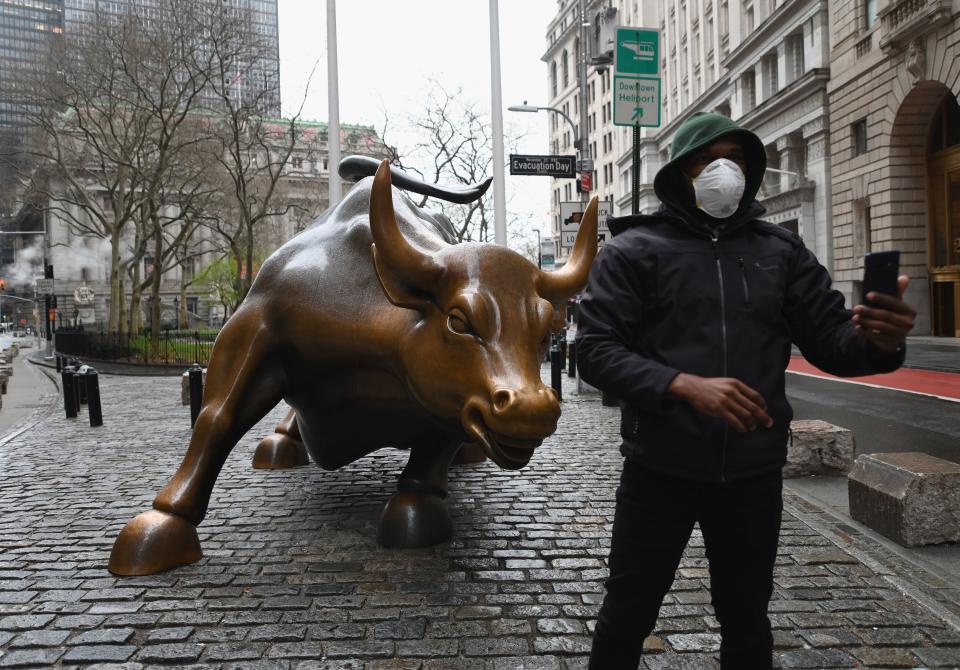Why calling the market bottom doesn't matter
With the S&P 500 (^GSPC) down 34% since its February highs, the word “bottom” has been spoken frequently in Wall Street research notes and in the financial media.
The stock market has experienced significant drops more rapidly than in the past – and some investors see parallels between now and the 2008 crisis, and are looking to speed things up a little.
As Yahoo Finance managing editor Sam Ro wrote on Monday, “the stock market, in theory, is a discounting mechanism. In other words, it prices in what’s expected to happen more than what already has.” And that means that a bottom is only formed when the long-term risks are managed and investors can see some sort of light at the end of the tunnel.
That means that right now, the market is seeing the coronavirus situation in a pretty bad light, and it’s only getting worse. On Monday, the S&P 500 index fell sunk even further, almost 7%.
“Markets often stop going down when investors can rule out the most nightmarish scenarios,” Ro noted.
Calling a bottom based on public health data and economic data — when the bad news finally abates and good news comes — could be a way to do it. Or looking at the rollercoaster-like graphs on Yahoo Finance and deciding that the pessimism is completely priced in. The point here: it’s really hard to know when the bottom is the bottom.

But it doesn’t actually matter that much
It’s certainly true that a person investing $10,000 in cash when the S&P 500 is at 2,200 will get more money back when the market eventually recovers than someone who puts money in at 2,400 — this could be in a long time but there’s consensus that the market will eventually recover.
DataTrek’s Nicholas Colas, a veteran hedge funder, addressed this question in a note on Monday: what did you give up if you missed the bottom and bought one to three months later.
The answer? Not much.
“Any stock bought a month AFTER the lows was up 30.1% at year-end 2009,” he wrote. “Any stock bought 2 months after the lows was up 20.0% at year-end. Any stock bought 3 months after the low was up 18.4%.”
If you invested during all three periods, you’d be up 22.6% at year-end.
The bottom line here, Colas wrote, was to “not worry about buying the absolute bottom of any market rout because there will be plenty of performance available once it happens convincingly.”
This is a convenient answer, because we don’t know when the bottom is until after we’ve reached it. Colas, writing two weeks ago, pointed out that the “Financial Crisis Playbook” stipulates investors should buy equities after big drops. “History says this dollar-cost averaging approach should yield good forward 1-year returns,” he wrote.
Dollar cost averaging, or buying at regular intervals, is an easy way to hedge against ups and downs in the market and will ensure that investors can enjoy the bottom without risk missing it.
“History shows that most of the worst days tend to occur unexpectedly, making them nearly impossible to predict, and many of the best days occur soon after the worst days,” wrote BMO in a recent note.
With the volatility we’re seeing during the coronavirus crisis, we are seeing the worst and best days clumped together, though the overall trend has been decidedly down. But the point here is you never know what will happen or when the gains will come.
Missing them is very bad. Bank of America Global Research spells out the long-term scenario for investors who miss the gains: “Since the 1930s, if an investor sat out the 10 best return days per decade, his/her returns would be just 91% compared to ~15,000% (14,962%) returns since then.”
BMO has the short-term version of this, for the last bull market. It’s equally stark: “Since the start of this bull market, the S&P 500 has generated a 15.5% annualized price return,” BMO wrote. “Excluding the five best days each year through 2019 would reduce that return to just 1.1%.”
(Of course, BMO adds that if you could magically remove the five worst and keep the five best, you’d get a return of 33.4%.)
But there is no magic here.
“As such,” BMO continued, “we believe it is more beneficial for investors to maintain their investment discipline instead of trying to time the market.”
--
Ethan Wolff-Mann is a writer at Yahoo Finance focusing on consumer issues, personal finance, retail, airlines, and more. Follow him on Twitter @ewolffmann.
Here’s how long it usually takes to recover from a bear market
Companies face fresh security risks due to people working from home
Why it's important to still own stocks at retirement — even now
Fidelity, Vanguard, T. Rowe Price to investors: 'Stay the course'
Coronavirus price gouging: 3 charts show Amazon's wild spikes
Read the latest financial and business news from Yahoo Finance
Follow Yahoo Finance on Twitter, Facebook, Instagram, Flipboard, LinkedIn, YouTube, and reddit.